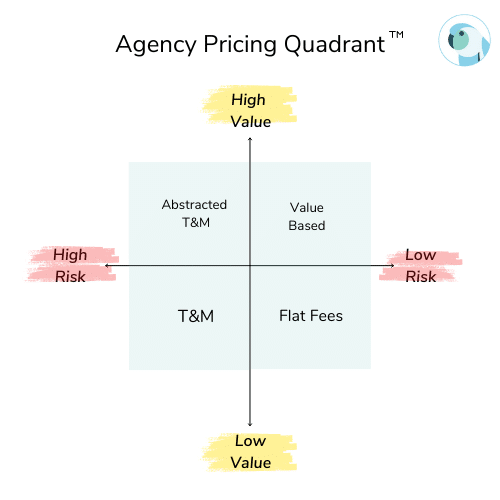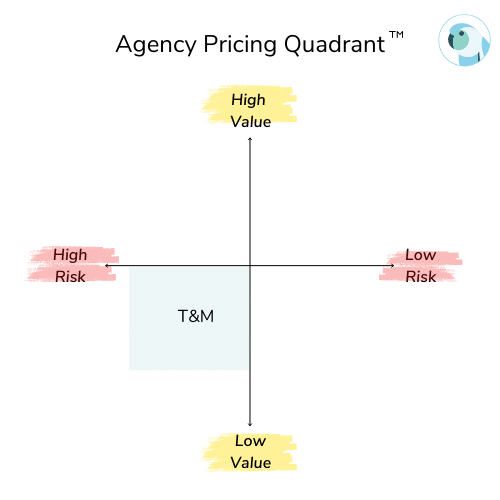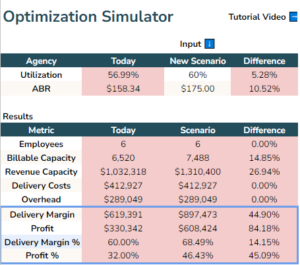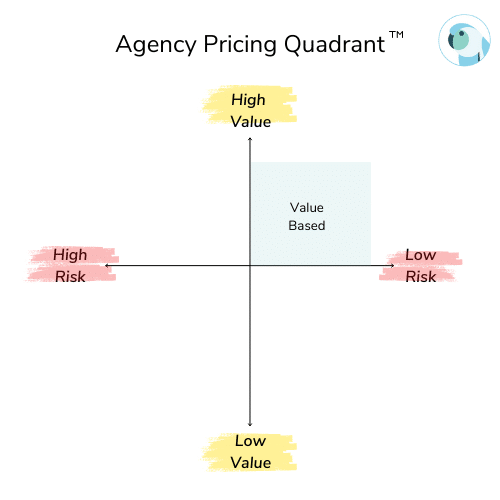When it comes to agency performance, pricing is undoubtedly one of the most exciting topics to discuss. This is understandable given it’s far more appealing than the rather more dry subjects of metrics and forecasting.
In this post, we’ll be delving into pricing models for your agency. We understand that choosing the right one can be daunting. Determining if your current pricing model is serving you well is a challenge in itself, nevermind the notion of possibly making it worse… that’s the stuff of nightmares.
Perhaps you already have a few pricing models in mind – such as fixed rates, value-based pricing, and hourly/T&M. However, figuring out which model to use can be overwhelming. This rings particularly true when considering the unique nuances of your business and the subtle differences in each service offering.
You may have heard some dogma (on the internet, obviously) around the alleged inferiority of a certain pricing model, or that you can’t scale an agency by selling hours. I’m here to let you know that none of that is mathematically true. What you should be focussing on is how to identify the right model for the right circumstance. You need to start recognizing that one pricing model may not be the right fit for every service you provide, or every client you serve.
Thankfully, you’ve come to the right place. We’re here to help you implement a simple pricing framework that will work for any service offerings spanning an array of situations.
With our guidance, you can cultivate confidence knowing you’re pricing your services correctly – while maximizing your profitability.
Struggling to choose the right pricing model for your agency? Let’s talk — book a free call and get clarity on the best path forward.
What is an Agency Pricing Model?
Before we dive into the nitty-gritty of agency pricing models, let’s take a step back to ensure we’re all on the same page. At its core, a pricing model is a framework that determines how the price of a project is calculated and which variables influence said price.
A deep understanding of it is crucial for confidently negotiating with clients while ensuring that your projects remain profitable after the deal’s closure. Grasping the big picture of your pricing model is key for making informed decisions about how to price your services plus the variables to consider.
The result? You’ll feel more secure in your pricing negotiations and have a better sense of how to maximize your profitability while delivering exceptional value to clients.
Things to Consider Before Choosing an Agency Pricing Model
When it comes to choosing your pricing model, ask yourself the following two questions to help decipher your ideal model:
- For the work that you’re doing, how much value are you providing?
- Again, for the work involved, how much risk are you taking on in the engagement?
Our framework, the Agency Pricing Quadrant, can help identify the best pricing strategy for your product/service to balance or mitigate risk.
We have two axes – Risk and Value. To identify where your product, or service, lands on the quadrant, you must find a home for it on both axes.
Let’s unpack how to think about Risk and Value.

Risk
For the horizontal axis, let’s assess your amount of risk. But first, we must define your risk in this instance. The level of risk involved in a project is determined by how accurately you can predict the time and cost required to complete the work.
Are You Low-Risk?
In simple terms, if you can accurately estimate within 10% of the project’s actual cost, you can position yourself on the Low-Risk side of the spectrum, which is on the right side of the axis.
Are You High-Risk?
On the other hand, if you’re providing a high-risk service – such as developing a custom enterprise software platform on a new technology stack with limited support – you would likely fall on the High-Risk side of the spectrum.
Another example of high-risk work would be an instance where the methodology required to deliver the work is inherently iterative or unpredictable. A common example of this is a project delivered using the Agile methodology which in principle relies on learnings from a short “sprint” of work to determine what happens next.
Value
When it comes to determining where your service lands on the value continuum, there are two primary factors to consider…
1. How specific is your positioning?
Consider a scenario whereby you have a graphic design firm and compare it to a firm that specializes in visualizing complex data through graphic design. It’s not necessarily about how commoditized the service is, but rather how specific your positioning is.
Both might be selling a highly commoditized service (graphic design), but it’s the positioning that starts to change the degree to which the client perceives the number of alternative options available to them.
- The position of graphic design firms puts you in a category with thousands of other options.
- The positioning of a specialized firm in system visualization puts you in a category with just a small handful.
So, the first factor in finding your home on the value scale will be dependent on how you are positioned. The second factor pertains to your Relative Value.
2. What is the Relative Value to your client?
The Relative Value involves considering the value your service has for a business – based on their context.
For example, if you specialize in conversion rate optimization for websites; what is the value of increasing your website’s conversion rate by 1%? The answer to this is going to depend on what a conversion is worth to you, and how many of them you undertake every month.
- If you sell $100M worth of product on your website, 1% is worth $1M
- If you sell $100 worth of product, it’s worth $1
Other relative factors include the scale of the business, the industry you are in, plus the importance of that problem based on their industry/regulatory environment. Additionally, consider any changes to your market that could exacerbate a problem or make an opportunity larger.
In BOTH of these factors, it’s important to highlight perceived customer value. How valuable you think the product/service is, or what it costs to deliver, is irrelevant. The only thing that matters is how valuable these things are in the eyes of the client.
Types of Agency Pricing Models
Now that you have a few of your services mapped out on the Agency Pricing Quadrant, let’s discuss each quadrant and the things you might want to keep in mind if you choose to price your service in this way.
Time and Materials (T&M)
What is T&M Billing?
Time and Materials (T&M) billing is a method of invoicing clients for the hours worked by a service provider (such as a consultant or contractor) and the cost of materials used for a particular project or service.
This billing method is often used in situations where the scope of work/project requirements are unclear or subject to change, thus making it difficult to determine a fixed price in advance. With T&M billing, the client pays for the actual time spent and materials used. This can provide flexibility for both the service provider and the client.
Example of T&M Billing
Let’s say you’re selling websites, and we’ve agreed to pay you $100 for each hour your team works on a website; this would be T&M billing. The materials side of this would be any software licenses, third-party services, and/or tools required to develop and launch said website.
If it takes the team 150 hours to complete the website, plus $5000 in material expenses, the cost to the client would be: $100 x 150 hours + $5000 = $20,000

T&M Pros
One effective way to share risk with clients is by using a T&M billing model – as long as you can bill for all the hours while ensuring a healthy margin between your hourly rate and your average cost per hour.
This model can be particularly beneficial if you have a low-cost delivery approach. Why? It creates a sense of value for clients and enables you to compete on price by focusing on your low hourly rate.
Time and Materials billing is a widely used business model that is supported by various financial and operational tools alongside methods for measuring, projecting, and reconciling profitability. This model is well-suited for situations whereby you’re selling highly competitive or low-value services in a commoditized market that are also high-risk, iterative, or difficult to scope. By leveraging this billing model, you can more effectively manage risk, while ensuring that both you and your clients are getting the best possible value.
T&M Cons
While time and materials billing can be a useful approach for certain situations, it’s important to consider its limitations too. For instance, this model can be very poor at leveraging high-value scenarios. It may also require detailed timekeeping models that can be both time-consuming and tedious. A winning combination… Additionally, it can lead to lazy scoping, thus undermining your ability to accurately forecast project timelines and costs.
Another downside to T&M billing is that it can set a ceiling on talent costs, which can limit your ability to attract and retain top talent. Moreover, it may be more challenging to sell this model to clients, as it requires them to take on more risk. This can be especially difficult if you have a high-cost delivery model, as clients may be hesitant to commit to an open-ended billing structure.
Despite these challenges, Time and Materials billing can still be a viable option for certain situations, and it’s important to weigh the pros and cons carefully before deciding which approach to take.
Best For
There are specific scenarios in which Time & Materials can be the most effective choice – most notably, when selling low-value services in a commoditized market that are high-risk, iterative, or difficult to scope.
This is especially true if your delivery model is low-cost, such as using offshoring resources, leveraging high-tech tools, or utilizing junior resources. The low cost can help create the perception of value given a lower hourly rate is required to meet gross margin targets.
Flat Fee
What is Flat Fee Billing?
Flat fee pricing (AKA fixed fee pricing), is a billing method in which a service provider charges a predetermined, fixed price for a specific service or project – regardless of the amount of time or resources required to complete it.
Example of Flat Fee Billing
Keeping the examples in-line with our website build example; a flat fee-based website build could be $20,000 to complete the project, no matter how long it takes to complete (assuming the scope of work remains the same).

Flat Fee Pros
A flat fee pricing model is an effective strategy to increase rates without creating the perception of higher costs for clients. This approach also creates more separation between delivery costs and pricing, allowing for increased margins. Additionally, the fixed price model rewards predictable delivery models and encourages team efficiency, making revenue and cost forecasting simpler. With its low-risk structure, this pricing model can be a more straightforward and less risky option for clients to choose. This makes it easier for businesses to sell their services and establish long-term relationships with their clients.
Flat Fee Cons
A flat fee pricing model places all the risk on you. It requires your agency to either scope projects very accurately or price the remaining risk into the deal. This pricing model can also lead to lazy time-tracking and cost-tracking, which undermines the agency’s ability to measure profitability and performance. Additionally, it can set a ceiling on pricing, thus limiting the agency’s ability to charge higher rates.
Finally, it may be more difficult to sell to clients in situations where there is still a lot of project risk that needs to be priced in. It can also create a lot of additional friction in managing changes to scope, or revisions, as these will often instigate a conversation about issuing a change order. Overall, this pricing model requires careful consideration and strategic planning to ensure success.
Best For
A flat fee structure is great for situations in which you are selling highly competitive and/or low-value services which are reasonably low-risk or easy to scope. The flat fee can create the perception of value and allow your agency to arbitrage the low-risk nature of the work, while focusing on efficiency to increase margins (spending less time and money to complete the work).
Are you interested in modelling what your agency could look like with an optimized pricing model, bringing in X amount more each year because of it? The Agency Model Generator is part of a free toolkit that Parakeeto offers:

Abstracted Time and Materials
What is Abstracted T&M?
Abstracted T&M is the practice of billing T&M without ever having the “hourly” conversation. It’s a situation whereby you sell your service but abstract the amount you’re charging away from an amount of hours to complete the project and towards blocks of time (such as weeks, months).
You bill them on a set cadence for however long it takes to do it. For example; you’re offering an app development service, so you could frame it as “$5000 a month to get our team to work on your app, for however long it takes to get the job done.”
Example of Abstracted T&M
Using our now classic ‘website build’ scenario, you would sell a client on hiring your team for a website build, and framing the cost as being $5000 per two-week sprint for however many sprints it takes to complete the build. You may provide an initial range of sprints based on the current scope of work – providing a range of 3-5 sprints ($15,000 to $25,000), for example.
In this time frame, the client will have a cross-functional website design and development team, working against a backlog of features and requirements for said website.

Abstracted T&M Billing Pros
This is an effective strategy for managing risk with your clients and maximizing value by employing a technique that involves sharing risk and arbitraging higher-value situations. By doing so, you can create a greater distinction between delivery cost and price, which can lead to that coveted increase in profit margins. Moreover, this approach allows you to move away from discussions centered on hourly rates while still sharing risk with your clients using Time & Materials contract mechanics.
This method is particularly useful if you have a high-cost delivery model, enabling you to leverage value to increase your rates without raising the perception of cost for your clients. Additionally, this strategy can eliminate the need for timesheets and simplify operations and forecasting models by introducing resource-plan based time-tracking.
Ultimately, implementing this approach can lead to extremely predictable margins – assuming your cost rates and billing rates remain relatively in line. An additional benefit is that changes to scope can be handled fluidly, as new features are simply added to the backlog and prioritized. Clients can continue to extend the project and request additional work – as long as they’re paying your team retention fee.
Abstracted T&M Billing Cons
While Abstracted T&M sounds super on the surface, it’s important to note that certain strategies may be more effective than others, depending on the situation. It’s also worth noting that this strategy generally requires a high-value client scenario to be truly effective.
This is a less common pricing model and will often sound foreign to clients. To begin selling and managing engagements in this way can present a challenging learning curve. Additional drawbacks to this approach include limited rewards for increases in efficiency plus the risk of lazy scoping which, again, can undermine your ability to accurately forecast.
Moreover, this strategy can set a ceiling on talent costs and may be more challenging to sell to clients as it requires more risk on their part. It’s important to carefully consider these factors when evaluating whether this approach is the right fit for your business.
Best For
Abstracted T&M is great for situations where you’re selling high-value work that is complex in nature, requires an iterative approach, or is simply difficult to scope up-front.
Value-Based Pricing
What is Value-Based Billing?
This method involves pricing services based on the value they provide to the customer, rather than on the cost of production, or indeed the market price. It requires a keen understanding of the customer’s needs, preferences, plus willingness to pay, and pricing the product/service accordingly to capture the perceived value.
Example of Value-Based Pricing
A website build using Value-Based Pricing entails pricing the services based on what kind of client you’re serving AND how valuable that service is to said client. For example, if you were building a website for a large e-commerce company doing $10,000,000 in online sales per year, you may use a value-based selling approach. You could ascertain that a new site could boost their sales by 10% ($1M per year) and charge $100,000, justifying the price as being merely 10% of the upside they stand to gain from the new website!

Value-Based Pricing Pros
When it comes to maximizing profitability, one approach that has gained a ton of popularity recently is Value-Based pricing. At the surface level, you’ll be able to charge a lot more for your work. Additionally, this approach rewards predictable delivery models and increases in efficiency, which can further enhance your profitability.
This strategy can also simplify revenue and cost forecasting, particularly when your delivery models are low-risk. Furthermore, by taking on more risk from the client in performance-based scenarios, you can reduce sales friction and increase your chances of success. Overall, if you’re looking to boost your profits and streamline your operations, leveraging high-value clients and scenarios by billing based on the value you provide could be the way to go.
Value-Based Pricing Cons
Value-Based pricing can be effective in certain scenarios but comes with a major downfall – that being taking on all the risk as an agency. While this can provide a degree of peace of mind to clients, it can also be challenging if the work undertaken is risk inherent. Additionally, this approach requires accurate project scoping, or pricing remaining risk into the deal, which can be difficult to do in practice. It’s also worth noting that taking on all the risk can lead to lazy time and cost tracking, which can – say it with me now – undermine your ability to measure profitability and performance!
Furthermore, if the client scenario is low-value, this approach may result in lower pricing. Additionally, navigating value conversations with clients and properly attributing results can be complex, plus require strong sales skills. Taking on all the risk can be difficult to sell to clients in situations where there is still a lot of risk in the project that needs to be priced in, or the client is value conversation adverse… All of these factors should be carefully considered when deciding if the value conversation is really worth having for your agency.
Best For
This form of approach is optimum if you’re selling very high-value work that is reasonably predictable in nature, or easy to scope. It’s especially good in situations where the outcomes for the client are de-risked.
How Pricing Models can Affect Profitability
At the end of the day, the way you bring money into the agency isn’t actually as important as ensuring you have a strong Delivery Margin.
You can price essentially price any way you want – as long as those margins make sense and everyone is happy with the deal. Increases in price, or decreases in cost, are only effective to the degree in which they increase the ratio of AGI to Delivery Cost (Delivery Margin).
It’s important to have a deep comprehension of which variable to play with in order to achieve a healthy ratio in your engagements.
As a general rule of thumb, whatever pricing model you land on should enable you to target a 60%+ delivery margin on engagements.
In Summary
The bottom line is this; in the current agency space, the practice of billing clients based on Time & Materials is widely considered outdated and largely undesirable. It’s increasingly being replaced by Value-Based and Flat Pricing models, which are considered more forward-thinking and applicable to most agencies.
That said, we hold strong that Time & Materials billing (particularly in its Abstracted versions) can still serve a valuable purpose in this industry, providing an equitable model for agencies who solve problems that are high-risk, complex, or require iterative approaches.
At the end of the day, choosing the right pricing model for a given engagement ultimately comes down to understanding how much risk and value lies in that engagement. From there, you can choose the option that is most likely to balance delivery cost and revenue. Not only should it lead to a healthy margin for your business, but also a palatable price for your client.








Are T&M and Flat Fees in the correct quadrants?
If all the risk is on the agency for Flat Fees, it would seem to be high risk.
Hey Jen,
Great question!
Both the risk and value axies refer to how risky and valuable the work is. So in this scenario, if the work is high-risk (meaning it is likely to have a lot of variability in the scope, or is difficult to predict) we would want to share risk with the client by employing T&M pricing models. Whereas if the work is low in risk, we would arbitrage that opportunity by taking on more risk and pricing upside into the flat or value-based price.
Does that make sense?